
Station Name: EAST WINCH[Source: Glen Kilday]
East Winch Station Gallery 1 Early 1950s - 29 August 1968 1c.jpg) Looking north-west at East Winch station from the signal gantry at the end of the up platform in the early 1950s before that platform was shortened. Note the flower beds at the back of the down platform. The signal box is on the far side of the level crossing and beyond that thje goods yard is on the right. There were no substantial buildings in the goods yard although the need for a goods shed was discussed by the board in 1858 but it was never built. The purpose of the building on the right is not known; it was left standing when the platforms were shortened and may have been a lamp room.
Photo Ken Blatch, East Winch station master  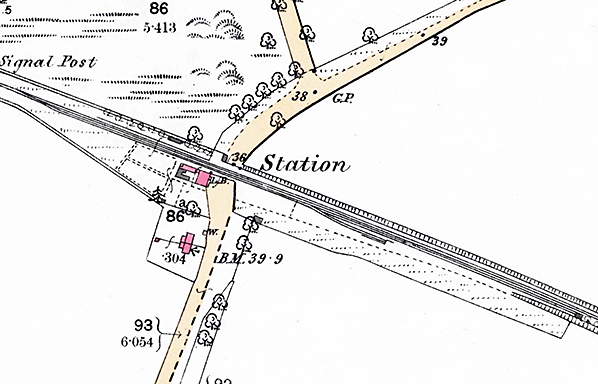
1885 1:2,500 (25") OS map. At this time the signal box at East Winch hadn’t yet been provided. LB indicates the station had a post box. Although there are two tracks running tjrough the station the track facing the main station building is a siding, there is only one platform on the down side - the platform edge is clearly seen.

1905 1:2,500 (25") OS map At East Winch, by 1905, the station appeared as it would exist up to the withdrawal of goods services in 1964. The signal box was in place and additional sidings and a dock for goods traffic had been built east of the road crossing; the longer siding has been lengthened. An up platform is now shown in front of the main station building. A new building has been provided and the west end of the up platform; its purpose is unknown but it may have been a lamp room. It is seen in some of the pictures including the early 1950s picture above. Click here to see a larger version.
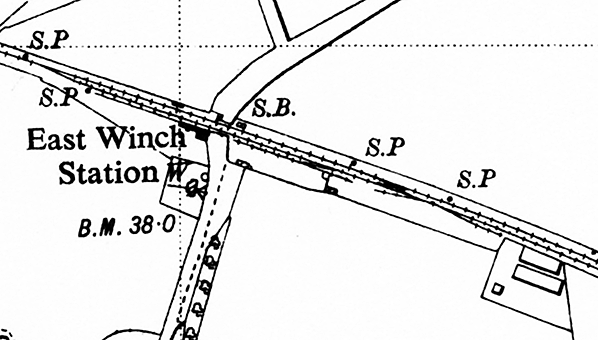
1950 1:10,560 (6") OS map. Two large buildings are shown at the east end of the goods yard. It is not known of they had any rail connection although there is no obvious route to them other than through the goods yard. The track layout remains the same as in 1905.
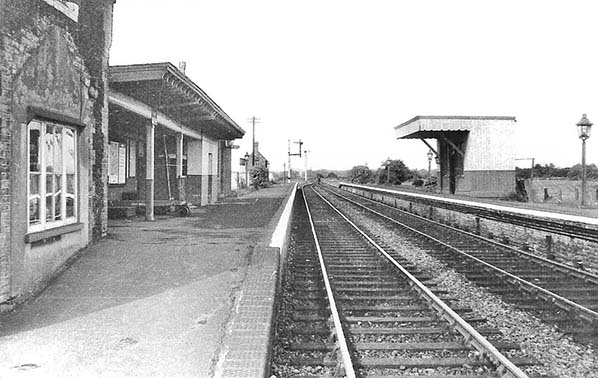 East Winch station looking north-west from the level crossing looking towards King’s Lynn in 1955. Lower quadrant signals were still in use at the time.
Photo from John Mann collection 1a.jpg)
In April 1958 ex-GER Class J17 0-6-0 No.65521 waits in goods siding at East Winch. This locomotive had, along with other class members, spent some time at South Lynn shed but by the time she was photographed she was shedded at King's Lynn. She was steam-braked only and carries the Class 8 headcode. Apart from on the footplate, no staff are evident and no shunting appears to be ongoing so it is possible the train, too long for the loop, has been refuged to allow a passenger train to clear the running line. New in 1901 as GER No.1171, BR No.65521 was to survive until February 1962. One class member, No.65567 has survived into preservation and this machine is thought to have worked the final steam-hauled passenger train on the King's Lynn - Dereham line when she worked the RCTS Great Eastern Commemorative Steam Tour on 31 March 1962.
Photo by Brian Easter 1b.jpg) In August 1958 an LMS designed, BR built Ivatt 'Flying Pig' 2-6-0 No. 43090 passes East Winch bearing the express passenger headcode. This loco was allocated brand new to South Lynn shed in December 1950. As far as can be seen, the train is a 9-car rake comprising BR MkI and Gresley vehicles. The train length was unusual for this line by this date and South Lynn shed nominally serviced the former M&GN route so the identity of this train is rather a puzzle. Perhaps it was a special or excursion. The Ivatt 4MTs at South Lynn were destined to relocate 'round the corner' to King's Lynn ex-GER shed and were a not uncommon sight on the Swaffham line, often turning up on the line's final timetabled steam-hauled passenger train; a Saturdays Only King's Lynn - Swaffham and return service. At extreme left is evidence of the Down platform having been cut back while the platform edge as been renewed, both occurring during the 1950s. By the time the line closed in 1968 the lower quadrant Up Home signal had been replaced by an upper quadrant Down Starter with the Up Home being replaced by an upper quadrant with backboard located on the opposite side of the track. East Winch yard had no substantial buildings. Those seen on the right were built in the 1950s and are assumed to have no railway connection. In August 1958 an LMS designed, BR built Ivatt 'Flying Pig' 2-6-0 No. 43090 passes East Winch bearing the express passenger headcode. This loco was allocated brand new to South Lynn shed in December 1950. As far as can be seen, the train is a 9-car rake comprising BR MkI and Gresley vehicles. The train length was unusual for this line by this date and South Lynn shed nominally serviced the former M&GN route so the identity of this train is rather a puzzle. Perhaps it was a special or excursion. The Ivatt 4MTs at South Lynn were destined to relocate 'round the corner' to King's Lynn ex-GER shed and were a not uncommon sight on the Swaffham line, often turning up on the line's final timetabled steam-hauled passenger train; a Saturdays Only King's Lynn - Swaffham and return service. At extreme left is evidence of the Down platform having been cut back while the platform edge as been renewed, both occurring during the 1950s. By the time the line closed in 1968 the lower quadrant Up Home signal had been replaced by an upper quadrant Down Starter with the Up Home being replaced by an upper quadrant with backboard located on the opposite side of the track. East Winch yard had no substantial buildings. Those seen on the right were built in the 1950s and are assumed to have no railway connection.Photo by Brian Easter 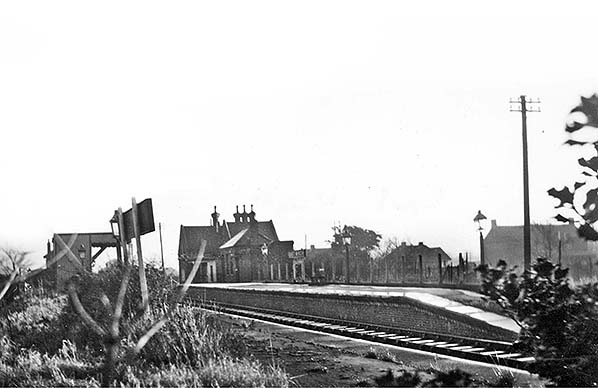
On 22 December 1962 at East Winch station maintenance was slipping at East Winch. The platforms are weedy and the once tidy shrubberies overgrown.
Photo copyright G C Lewthwaite 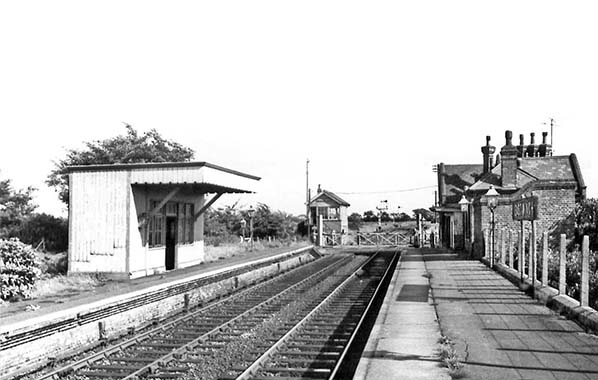 Looking south-east from the up platform at East Winch station in 1968. The station retained its status as a passing place until the line closed later that same year. Looking south-east from the up platform at East Winch station in 1968. The station retained its status as a passing place until the line closed later that same year.Photo from John Mann collection
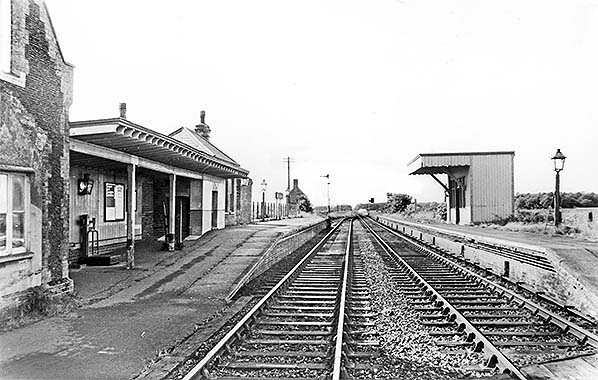
The view towards King’s Lynn at East Winch in 1968. Comparison with the 1955 image from the same place shows that the signals had been replaced and the station has a more unkempt and run-down air, otherwise little had changed. Note the scales under the canopy on the left.
Copyright photo from Stations UK
A two-car Metropolitan Cammell DMU called at East Winch to exchange single line tokens on its way from King’s Lynn to Norwich in this undated photo. Steam locomotives ceased running on passenger trains in September 1955 and the line closed in the same month in 1968.
Photo from John Mann collection 5a.jpg) East Winch station on a wet day on 29 August 1968, a few days before the station closed. No passengers are seen, the man at the end of the platform is likely to be a member of staff as an exchange of single line tokens was required at East Winch. East Winch station on a wet day on 29 August 1968, a few days before the station closed. No passengers are seen, the man at the end of the platform is likely to be a member of staff as an exchange of single line tokens was required at East Winch.Photo by Steve Wright Click here for East Winch Station Gallery 2:
|
 No signal boxes were provided when the line was built. The Great Eastern Railway constructed them later, in the case of East Winch on the down side beyond the level crossing from the passenger facilities, thus the box was nearer the meagre provision for goods traffic. When the 1905 25inch OS Map was surveyed there were two platforms and the station was a passing place for trains. The previous map in the same series, dated 1885, shows a much simpler layout at East Winch than is shown on the later edition. It would not have allowed through trains to pass except by use of a siding. In this map there is a single platform and running line on the down side opposite the station buildings. Between the building and the main line a long siding, shunted from the west, passed through the station and shared the road crossing with the running line. A short siding branched off the longer one east of the road and led to a loading or cattle dock. In Nov 1879 a horse/carriage dock was approved for the Earl of Romney 'and others' travelling to Lynn. The Romney seat was and still is nearby Gayton Hall. It is currently occupied by the 8th Earl and his Countess.
No signal boxes were provided when the line was built. The Great Eastern Railway constructed them later, in the case of East Winch on the down side beyond the level crossing from the passenger facilities, thus the box was nearer the meagre provision for goods traffic. When the 1905 25inch OS Map was surveyed there were two platforms and the station was a passing place for trains. The previous map in the same series, dated 1885, shows a much simpler layout at East Winch than is shown on the later edition. It would not have allowed through trains to pass except by use of a siding. In this map there is a single platform and running line on the down side opposite the station buildings. Between the building and the main line a long siding, shunted from the west, passed through the station and shared the road crossing with the running line. A short siding branched off the longer one east of the road and led to a loading or cattle dock. In Nov 1879 a horse/carriage dock was approved for the Earl of Romney 'and others' travelling to Lynn. The Romney seat was and still is nearby Gayton Hall. It is currently occupied by the 8th Earl and his Countess. 
 East Winch was one of five intermediate stations on the Lynn & Dereham that, soon after opening, had become request stops. The timetable for 1866, just twenty years into the line’s existence, offered only four trains in each direction, the first towards Lynn as late as 10.50am. Passengers for the Dereham direction had their first choice at 9.13am. The station was not an ’unstaffed halt’ but passengers wishing to travel had to arrive five minutes before the advertised time. Those wishing to leave the train had to inform the guard earlier in the journey. On Saturdays an extra train ran to Norwich for its market, leaving East Winch at 8.03am: returning market-goers caught the 5.20pm from Norwich and changed at Dereham. There was no equivalent help to reach the Lynn Tuesday Market.
East Winch was one of five intermediate stations on the Lynn & Dereham that, soon after opening, had become request stops. The timetable for 1866, just twenty years into the line’s existence, offered only four trains in each direction, the first towards Lynn as late as 10.50am. Passengers for the Dereham direction had their first choice at 9.13am. The station was not an ’unstaffed halt’ but passengers wishing to travel had to arrive five minutes before the advertised time. Those wishing to leave the train had to inform the guard earlier in the journey. On Saturdays an extra train ran to Norwich for its market, leaving East Winch at 8.03am: returning market-goers caught the 5.20pm from Norwich and changed at Dereham. There was no equivalent help to reach the Lynn Tuesday Market. 
 The Up platform was shortened at its west end during the 1050s. Steam passenger work ended with the British Railways Eastern Region summer timetable in 1955. The engine sheds at Swaffham and Dereham closed to steam and new Metropolitan Cammell and BR-built Derby DMUs were allocated to the route. The service was increased to a level without precedent with twelve weekday trains calling at East Winch in each direction: two more called on Saturdays. One train each day ran to and from the Thetford branch. There were no Sunday trains between Dereham and Lynn.
The Up platform was shortened at its west end during the 1050s. Steam passenger work ended with the British Railways Eastern Region summer timetable in 1955. The engine sheds at Swaffham and Dereham closed to steam and new Metropolitan Cammell and BR-built Derby DMUs were allocated to the route. The service was increased to a level without precedent with twelve weekday trains calling at East Winch in each direction: two more called on Saturdays. One train each day ran to and from the Thetford branch. There were no Sunday trains between Dereham and Lynn. 
 Home Page
Home Page